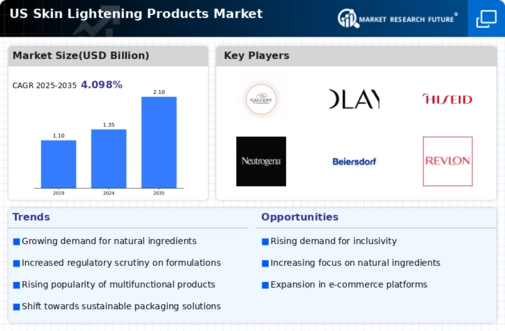Increasing Consumer Awareness
The skin lightening-products market is experiencing a notable surge in consumer awareness regarding skin health and aesthetics. This heightened awareness is driven by educational campaigns and social media influence, which emphasize the importance of skin care. As consumers become more informed about the ingredients and potential effects of skin lightening products, they are more likely to seek out products that align with their values and needs. This trend is reflected in the market data, which indicates that the demand for products with natural and safe ingredients has increased by approximately 30% over the past year. Consequently, brands that prioritize transparency and education are likely to gain a competitive edge in the skin lightening-products market, appealing to a more discerning consumer base.
Rising Demand for Personalization
Personalization is emerging as a key driver in the skin lightening-products market, as consumers increasingly seek products tailored to their unique skin types and concerns. This trend is indicative of a broader shift towards individualized beauty solutions, where consumers expect brands to offer customized options. Market analysis reveals that approximately 40% of consumers express a preference for personalized skincare products, which has prompted brands to develop targeted solutions that address specific skin issues. By leveraging data analytics and consumer feedback, companies can create products that resonate with their audience, thereby enhancing customer loyalty and driving growth in the skin lightening-products market.
Cultural Influences and Beauty Standards
Cultural perceptions of beauty play a significant role in shaping the skin lightening-products market. In the United States, diverse cultural backgrounds contribute to varying beauty ideals, with some communities placing a high value on lighter skin tones. This cultural influence drives demand for skin lightening products, as individuals seek to conform to these beauty standards. Market Research Future suggests that approximately 25% of consumers in specific demographics actively seek out skin lightening solutions. Brands that effectively navigate these cultural nuances and offer products that resonate with specific communities may find substantial opportunities for growth within the skin lightening-products market.
Influence of Social Media and Influencers
The skin lightening-products market is significantly influenced by social media platforms and the rise of beauty influencers. These platforms serve as powerful marketing tools, enabling brands to reach a wider audience and engage with consumers directly. Influencers often showcase their experiences with skin lightening products, which can sway consumer perceptions and purchasing decisions. Recent data indicates that approximately 60% of consumers are influenced by social media recommendations when selecting skincare products. As brands increasingly collaborate with influencers to promote their offerings, the skin lightening-products market is likely to see continued growth driven by this dynamic marketing approach.
Technological Advancements in Formulation
The skin lightening-products market is benefiting from technological advancements in formulation and product development. Innovations in cosmetic chemistry have led to the creation of more effective and safer skin lightening agents, which appeal to consumers seeking visible results without compromising skin health. For instance, the introduction of advanced delivery systems enhances the efficacy of active ingredients, making them more appealing to consumers. Market data indicates that products utilizing these advanced formulations have seen a sales increase of around 20% in the last year. As brands continue to invest in research and development, the skin lightening-products market is likely to witness a proliferation of innovative offerings that cater to evolving consumer preferences.























Leave a Comment